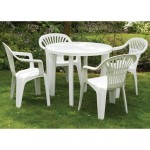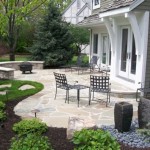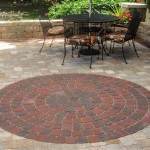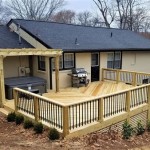How To Stop Water Pooling On Your Patio: A DIY Guide
Water pooling on a patio can be a significant issue, leading to a variety of problems ranging from aesthetic displeasure to structural damage. Standing water can foster mold and mildew growth, create slippery surfaces that pose safety hazards, and even contribute to the deterioration of the patio material itself. Therefore, addressing water pooling promptly and effectively is crucial for maintaining a safe, attractive, and long-lasting outdoor space. This article provides a comprehensive guide on identifying the causes of patio water pooling and implementing DIY solutions to rectify the problem.
Before embarking on any repair or modification, a thorough assessment of the patio and surrounding area is essential. This involves identifying the specific locations where water accumulates, observing the rate at which the water pools, and understanding the underlying causes contributing to the issue. Factors such as the patio's slope, the type of material used, the presence of obstructions to drainage, and the condition of the underlying soil should all be carefully considered.
Identifying the Causes of Water Pooling
The root cause of water pooling on a patio can often be attributed to a combination of factors. Accurate diagnosis is the first step towards developing an effective solution. Some common culprits include:
Insufficient Slope: Ideally, a patio should have a slight slope away from the house to facilitate proper water runoff. A general guideline is a slope of at least ¼ inch per foot. If the patio is level or has a negative slope (sloping towards the house), water will naturally accumulate in low spots. This is probably the most frequent cause of pooling water.
Clogged Drains: If the patio has existing drainage systems, such as drains connected to underground pipes, these can become clogged with leaves, debris, and sediment over time. A blockage prevents water from flowing freely through the drainage system, leading to water pooling on the patio surface.
Compacted Soil: The soil surrounding the patio can become compacted over time, particularly in areas with heavy foot traffic or where heavy objects are placed. Compacted soil reduces the soil's ability to absorb water, causing it to pool on the patio surface instead. This is especially relevant if the patio is adjacent to a lawn or garden.
Uneven Patio Surface: Over time, patio pavers or stones can shift, settle, or crack, creating an uneven surface with dips and depressions. These low spots act as natural collection points for water, leading to pooling. The type of material used for the patio often dictates how susceptible it is to this issue.
Poor Grouting or Sealing: In cases where a patio is constructed with pavers or stones, the grout or sealant between them may deteriorate over time. This allows water to seep beneath the surface and contribute to soil erosion or water pooling in low spots. Improper installation of the grouting or sealing also contribute to the problem.
DIY Solutions for Addressing Water Pooling
Once the cause of water pooling has been identified, appropriate DIY solutions can be implemented. The specific approach will depend on the severity of the problem and the resources available. These solutions can range from simple maintenance tasks to more involved structural adjustments.
Adjusting the Patio Slope: Correcting an insufficient slope is often a more involved project, but crucial to effective drainage. This can involve removing the existing patio surface, adjusting the grade of the underlying soil, and then reinstalling the patio material with the proper slope. For smaller patios, this may be a manageable DIY task. For larger patios, professional assistance may be required.
The process involves carefully removing the pavers or stones, ensuring they are kept intact for reuse. The underlying soil is then graded using a level and a hand tamper to create a consistent slope away from the house. Once the desired slope is achieved, a layer of compacted gravel can be added to provide a stable base for the pavers or stones. Finally, the patio material is reinstalled, ensuring consistent spacing and proper alignment. Using a string line can help maintain a consistent slope throughout the process.
Cleaning and Maintaining Drains: If clogged drains are the culprit, a thorough cleaning is essential. This can be accomplished using a variety of methods, including manually removing debris with a garden hose, using a plumbing snake to dislodge obstructions, or employing a wet/dry vacuum to suck out accumulated sediment. Regular maintenance, such as periodically flushing the drains with water, can help prevent future blockages.
It's advisable to regularly inspect drains after periods of heavy rainfall to identify and address any potential clogs promptly. Installing drain covers can also help prevent leaves and debris from entering the drainage system in the first place. These covers are relatively inexpensive and can significantly reduce the need for frequent cleaning. Consider using a pressure washer to blast any stubborn debris after manually removing visible debris.
Improving Soil Drainage: Addressing compacted soil can involve several different approaches. Loosening the soil around the patio with a garden fork or tiller can improve its ability to absorb water. Adding organic matter, such as compost or peat moss, can also help improve soil drainage and aeration. In severe cases, it may be necessary to install a French drain to divert water away from the patio.
A French drain consists of a perforated pipe buried in a trench filled with gravel. The trench is sloped away from the patio, allowing water to flow through the gravel and into the pipe, which then carries it away to a designated drainage area. The depth and length of the trench will depend on the amount of water that needs to be diverted and the topography of the surrounding area. The top of the trench can be covered with soil and grass, making it virtually invisible.
Repairing an Uneven Patio Surface: Correcting an uneven patio surface involves identifying and addressing the underlying causes of the settling or shifting. This may involve lifting and leveling individual pavers or stones, adding or removing sand or gravel beneath them, and ensuring they are securely seated. In cases where pavers or stones are cracked or damaged, they may need to be replaced entirely.
Using a rubber mallet can help gently tap pavers or stones into place without damaging them. It is important to ensure that the base beneath the pavers or stones is properly compacted and leveled to prevent future settling. Consider using polymeric sand to fill the gaps between the pavers or stones. This type of sand hardens when wet, providing a more stable and durable surface and preventing weeds from growing in the gaps.
Re-grouting and Sealing: If deteriorated grout or sealant is contributing to water pooling, it is important to remove the old material and apply new grout or sealant. This involves carefully scraping out the old grout or sealant with a grout removal tool and then cleaning the surface thoroughly. New grout or sealant should be applied according to the manufacturer's instructions, ensuring a smooth and even finish.
Choosing a high-quality grout or sealant that is specifically designed for outdoor use is essential for ensuring long-lasting protection against water damage. Consider applying a sealant to the entire patio surface to further enhance its water resistance. A penetrating sealant will soak into the patio material, providing protection from within. Regularly inspecting the grout and sealant and reapplying it as needed can help prevent water from seeping beneath the surface and causing further damage.
Preventative Measures for Long-Term Patio Health
Beyond addressing existing water pooling issues, implementing preventative measures can help ensure the long-term health and functionality of the patio. These measures are often simple and cost-effective, and can significantly reduce the likelihood of future problems.
Regular Cleaning: Regularly sweeping or washing the patio surface can help remove leaves, debris, and sediment that can clog drains or contribute to water pooling. Using a mild detergent and a scrub brush can help remove stubborn dirt and grime. Pressure washing can be effective for more thorough cleaning, but it is important to use a low-pressure setting to avoid damaging the patio material.
Proper Landscaping: Careful landscaping around the patio can help minimize the amount of water that reaches the surface. Planting trees and shrubs away from the patio can help reduce leaf litter and prevent root intrusion. Grading the soil around the patio to slope away from the surface can also help divert water away. Consider installing gutters and downspouts to direct rainwater away from the patio.
Seasonal Inspections: Conducting seasonal inspections of the patio can help identify potential problems early on. Check for signs of cracking, settling, or water pooling. Inspect drains for clogs and ensure that the soil around the patio is properly graded. Addressing small issues promptly can prevent them from escalating into more significant problems.
Proper Winterization: In regions with cold winters, it is important to properly winterize the patio to protect it from freeze-thaw damage. This may involve removing furniture and other items from the patio, covering the patio with a tarp, and applying a de-icing salt that is specifically designed for concrete or stone. Avoid using traditional rock salt, as it can damage the patio material.
By carefully assessing the causes of water pooling and implementing appropriate DIY solutions, combined with regular preventative maintenance, it is possible to maintain a dry, safe, and aesthetically pleasing patio for years to come.

How To Prevent Pooling Water On Patio Furniture Covers The Cover Blog

How To Keep Water From Pooling On Patio Furniture Cover

Beat The Rain How To Prevent Water Pooling On Your Patio Furniture Co F J Outdoors

How To Get Rid Of Standing Water On Your Patio

Water Puddling On Concrete Patio Every Time It Rains Diy Home Improvement Forum

What S Some Ideas To Help Water Drain Away From A Concrete Porch Hometalk

Need Drainage Advice For Water Pooling I Bunnings Work Community
Help Paver Patio With Standing Water Diy Home Improvement Forum

How To Install A Patio Drain

How To Prevent Rain Water From Pooling A Bunnings Work Community
Related Posts








